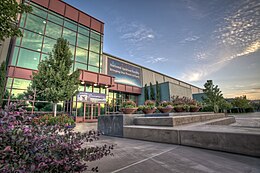
Back منشأة الإشعال الوطنية Arabic National Ignition Facility AST জাতীয় প্রজ্বলন সুবিধা Bengali/Bangla National Ignition Facility BS National Ignition Facility Catalan National Ignition Facility German National Ignition Facility Esperanto National Ignition Facility Spanish تأسیسات ملی احتراق و علوم فوتونی Persian National Ignition Facility Finnish


The National Ignition Facility (NIF) is a laser-based inertial confinement fusion (ICF) research device, located at Lawrence Livermore National Laboratory in Livermore, California, United States. NIF's mission is to achieve fusion ignition with high energy gain. It achieved the first instance of scientific breakeven controlled fusion in an experiment on December 5, 2022, with an energy gain factor of 1.5.[1][2] It supports nuclear weapon maintenance and design by studying the behavior of matter under the conditions found within nuclear explosions.[3]
NIF is the largest and most powerful ICF device built to date.[4] The basic ICF concept is to squeeze a small amount of fuel to reach pressure and temperature necessary for fusion. NIF hosts the world's most energetic laser. The laser heats the outer layer of a small sphere. The energy is so intense that it causes the sphere to implode, squeezing the fuel inside. The implosion reaches a peak speed of 350 km/s (0.35 mm/ns),[5] raising the fuel density from about that of water to about 100 times that of lead. The delivery of energy and the adiabatic process during implosion raises the temperature of the fuel to hundreds of millions of degrees. At these temperatures, fusion processes occur in the tiny interval before the fuel explodes outward.
Construction on the NIF began in 1997. NIF was completed five years behind schedule and cost almost four times its original budget. Construction was certified complete on March 31, 2009, by the U.S. Department of Energy.[6] The first large-scale experiments were performed in June 2009[7] and the first "integrated ignition experiments" (which tested the laser's power) were declared completed in October 2010.[8]
From 2009 to 2012 experiments were conducted under the National Ignition Campaign, with the goal of reaching ignition just after the laser reached full power, some time in the second half of 2012. The campaign officially ended in September 2012, at about 1⁄10 the conditions needed for ignition.[9][10] Thereafter NIF has been used primarily for materials science and weapons research. In 2021, after improvements in fuel target design, NIF produced 70% of the energy of the laser, beating the record set in 1997 by the JET reactor at 67% and achieving a burning plasma.[11] On December 5, 2022, after further technical improvements, NIF reached "ignition", or scientific breakeven, for the first time, achieving a 154% energy yield compared to the input energy.[12] However, while this was scientifically a success,[13] the experiment in practice produced less than 1% of the energy the facility used to create it:[14] while 3.15 MJ of energy was yielded from 2.05 MJ input,[15] the lasers delivering the 2.05 MJ of energy took about 300 MJ to produce in the facility.[13]
- ^ Clery, Daniel (December 13, 2022). "With historic explosion, a long sought fusion breakthrough". Science. doi:10.1126/science.adg2803. Archived from the original on December 24, 2022. Retrieved December 13, 2022.
- ^ David Kramer (December 13, 2022), "National Ignition Facility surpasses long-awaited fusion milestone", Physics Today, 2022 (2), American Institute of Physics: 1213a, Bibcode:2022PhT..2022b1213., doi:10.1063/PT.6.2.20221213a, S2CID 254663644, archived from the original on June 8, 2024, retrieved December 13, 2022,
The shot at Lawrence Livermore National Laboratory on 5 December is the first-ever controlled fusion reaction to produce an energy gain.
- ^ "About NIF & Photon Science". Lawrence Livermore National Laboratory. Archived from the original on December 2, 2017.
- ^ Hogan, W.J; Moses, E.I; Warner, B.E; Sorem, M.S; Soures, J.M (2001). "The National Ignition Facility". Nuclear Fusion. 41 (5): 567–573. Bibcode:2001NucFu..41..567H. doi:10.1088/0029-5515/41/5/309. ISSN 0029-5515. S2CID 250785362. Archived from the original on December 17, 2022. Retrieved December 17, 2022.
- ^ Nathan, Stuart (October 6, 2019). "Tracing the sources of nuclear fusion". The Engineer. Archived from the original on June 10, 2019. Retrieved June 10, 2019.
- ^ "Department of Energy Announces Completion of World's Largest Laser". United States Department of Energy. March 31, 2009. Archived from the original on April 1, 2009. Retrieved April 1, 2009.
- ^ "First NIF Shots Fired to Hohlraum Targets". National Ignition Facility. June 2009. Archived from the original on May 28, 2010. Retrieved September 13, 2009.
- ^ "First successful integrated experiment at National Ignition Facility announced". General Physics. PhysOrg.com. October 8, 2010. Archived from the original on December 13, 2022. Retrieved October 9, 2010.
- ^ Crandall, David (December 27, 2012). Final Review of the National Ignition Campaign (PDF) (Technical report). Department of Energy. p. 3.
- ^ An Assessment of the Prospects for Inertial Fusion Energy. National Academies Press. July 2013. p. 2. ISBN 978-0-309-27224-7.
- ^ Cite error: The named reference
:0was invoked but never defined (see the help page). - ^ Cite error: The named reference
igntion2022-llnlwas invoked but never defined (see the help page). - ^ a b "We have 'ignition': Fusion breakthrough draws energy gain". NBC News. December 13, 2022. Retrieved July 10, 2024.
- ^ "There is no "breakthrough": NIF fusion power still consumes 130 times more energy than it creates". Big Think. December 13, 2022. Retrieved July 10, 2024.
- ^ "Why the nuclear fusion 'net energy gain' is more hype than breakthrough". WHYY. Retrieved July 10, 2024.
© MMXXIII Rich X Search. We shall prevail. All rights reserved. Rich X Search